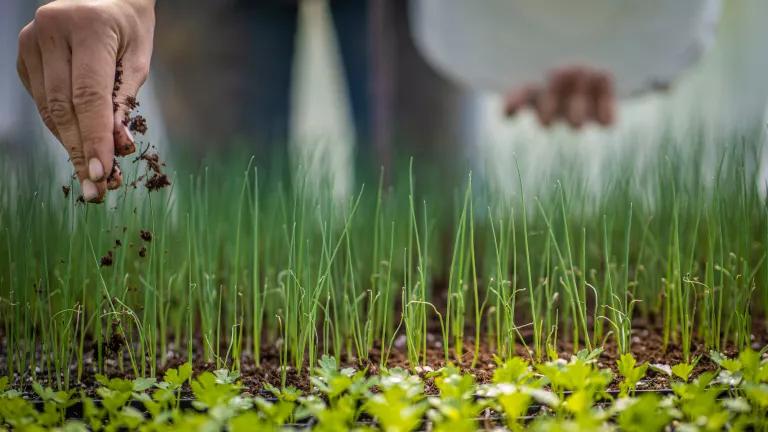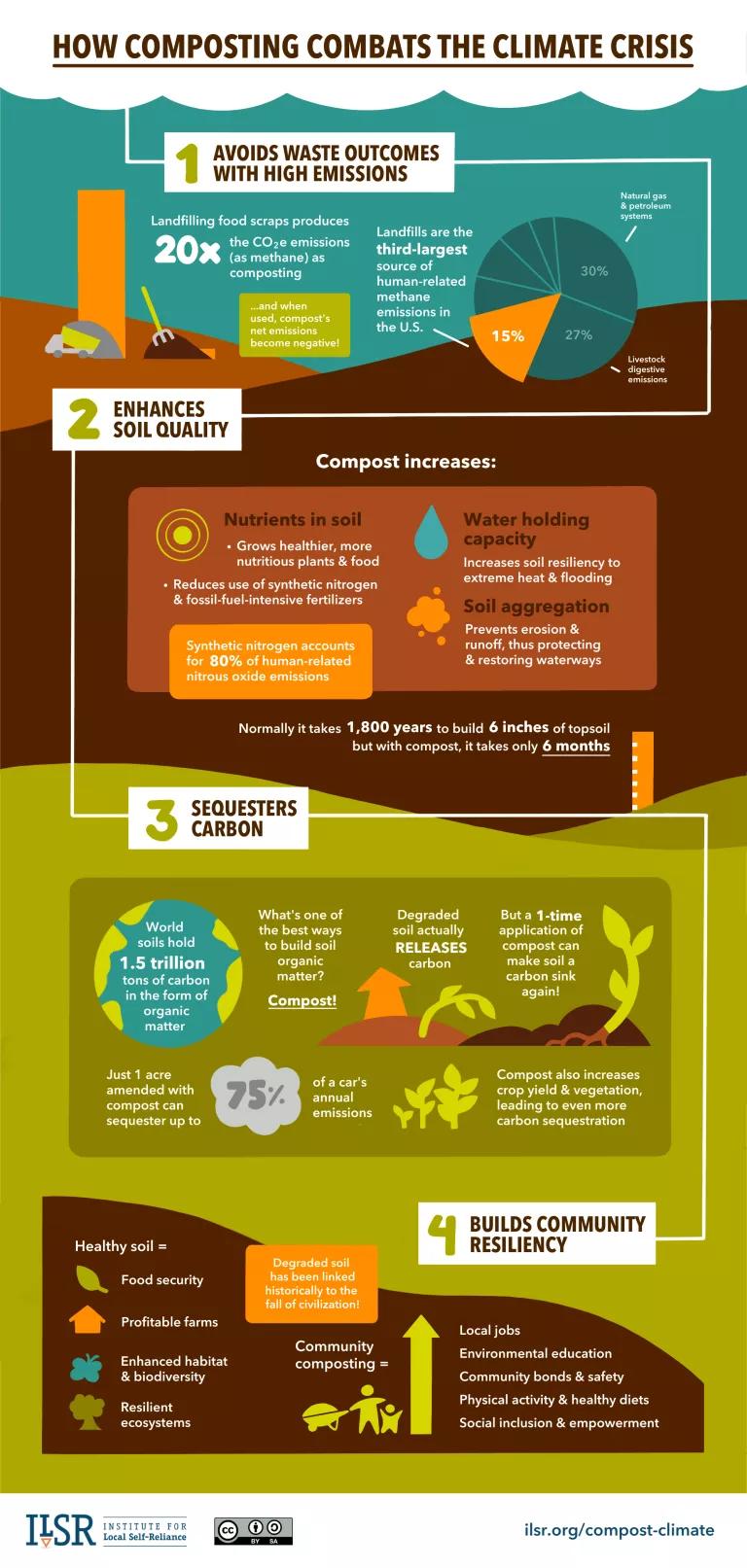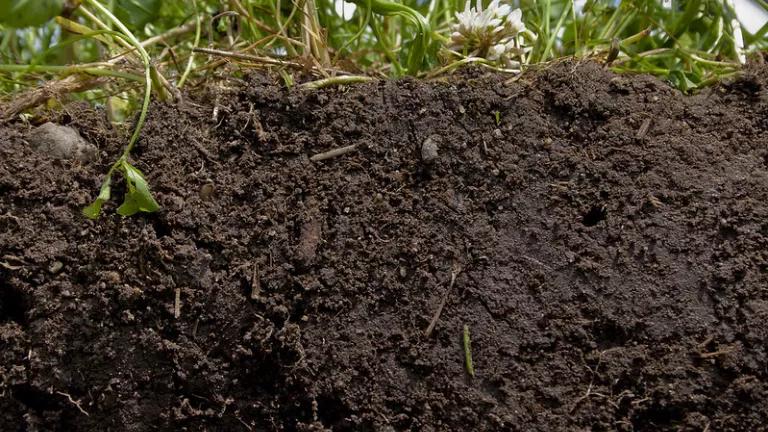Compost Is a Climate Solution
Reducing food waste is no. 1 on the list of most impactful interventions to mitigate climate change.

Compost being applied to organic crop seedlings at MX Morningstar Farm, a vegetable farm with retail store in Hudson, New York.
Preston Keres/USDA FPAC
People often underestimate the impact that reducing food waste can have on climate change. Yet Project Drawdown ranks reducing food waste as #1 on the list of most impactful interventions to mitigate climate change (scenario 1). Composting is one of the ways we can keep food scraps out of landfills, helping reduce landfill methane emissions. Composting can also help the climate by restoring soil health, which helps build resilience to climate-related changes, reduce reliance on synthetic fertilizers, and sequester carbon. Over the past several hundred years, soils have been depleted of organic matter through deforestation, urbanization, and industrial agriculture. That organic matter is made up of carbon as well as other nutrients such as nitrogen, phosphorus, and sulfur. Adding carbon alongside these other nutrients in the right proportions (such as those found in compost) can help that soil store more carbon for longer periods of time and keep it from being converted to greenhouse gases like carbon dioxide or methane. Today, World Soil Day, is a great opportunity to celebrate the role of compost in creating healthier soils and contributing to far-reaching climate solutions.
Compost can be made from a variety of organic materials, including food scraps that would otherwise end up disposed in landfills or incinerators. When we waste and dispose of food, we waste all the energy, land, fertilizer, water, labor, and resources that went into producing, processing, transporting, storing, and discarding that food, and create global warming pollution at every stage of the food system. In the U.S., wasted food is responsible for greenhouse gas emissions equivalent to the emissions from 50 million gas-powered cars (cars which, if lined up, would wrap around the earth nearly four times). While the best way to reduce the impacts associated with food waste is to prevent that food from being wasted in the first place, there will always be inedible food scraps and other organic materials that are discarded, and composting is a key solution to reduce the amount of organics that are landfilled or incinerated.
In the U.S., food is the most prevalent material in municipal landfills, comprising 24 percent of landfill content as of 2018. When food and other organic materials are disposed in landfills, they decompose and emit methane, a powerful climate pollutant with up to 80 times the heat-trapping potential of carbon dioxide. Landfills are the third largest source of human-generated methane emissions in the U.S., and food waste is responsible for over half of those emissions. Keeping food waste and other organic materials out of landfills is a critical priority in reducing global warming emissions.
Instead of letting food scraps pollute our air when we put them in landfills, we can compost them to help create the foundation of our food and farming system – soil. Farmers can use composted organic materials including food scraps to improve and fertilize soil, thereby reducing the need for synthetic fertilizer. Synthetic fertilizers are responsible for 1 percent of global energy use and 5 percent of global warming pollutants – more than global shipping and aviation combined – so substituting synthetic fertilizers with compost helps reduce energy demands and climate emissions. While compost is not a 1:1 equivalent for mineral fertilizer, it requires less energy to produce, provides nutrients, improves soil structure, and is a critical input in organic and regenerative farming systems. Also, the organic nitrogen present in compost is released more slowly over time than that of synthetic fertilizers, potentially contributing to longer-term soil fertility and reducing nitrogen loss and global warming potential.
In addition to reducing emissions, recycling food scraps and other organics into compost can also help our agricultural systems adapt to climate change by improving soil health. According to the Environmental Protection Agency, compost can “help build soil organic matter, which decreases bulk density, increases porosity, water retention, and infiltration, promotes nutrient cycling and retention, and stabilizes soil aggregates, reducing the risk of erosion.” Compost increases the ability of soil to hold water and improves drainage, helping reduce the amount of water needed to irrigate crops and reducing the impact of climate-change-driven extreme weather events such as droughts and floods.
Finally, adding compost to soils can increase the amount of carbon sequestered in soils, as well as improving the soil’s ability to store carbon. Numerous studies have shown that adding compost to soil increases soil carbon storage through increasing soil organic matter and boosting plant productivity.
Along with clear climate benefits, compost brings a wealth of other environmental, economic, and social benefits, including creating as much as twice as many jobs as landfilling and four times as many as incineration. In urban environments, composting at the home or community scale can help empower communities to build their own soils and local food production; compost can also be used to help remediate contaminated soil in environmental justice communities, contributing to greater health and equity outcomes. Instead of squandering food scraps through harmful disposal technologies such as landfilling and incineration, we need to boost the policies, practices, and priorities that ensure we turn discarded organic materials into the “black gold” of compost to help tackle climate change and create healthier, more resilient soils.

This infographic comes from the Institute for Local Self-Reliance (www.ilsr.org), a national nonprofit organization working to strengthen local economies and redirect discarded materials into local recycling, composting, and reuse enterprises. It is reprinted here with permission.
https://ilsr.org/compost-climate/; Creative direction by Brenda Platt and art by Clarissa Libertelli



